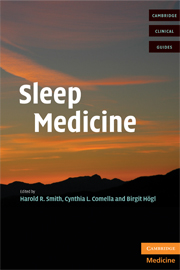Book contents
- Frontmatter
- Contents
- List of contributors
- Foreword
- SECTION 1 NORMAL SLEEP
- SECTION 2 SLEEP DISORDERS
- 3 Parasomnias
- 4 Circadian rhythm disorders
- 5 Excessive somnolence disorders
- 6 Insomnias
- 7 Restless legs syndrome and periodic limb movement disorder
- 8 Sleep apnea (central and obstructive)
- SECTION 3 SLEEP IN SPECIALTY AREAS
- Index
- References
8 - Sleep apnea (central and obstructive)
from SECTION 2 - SLEEP DISORDERS
Published online by Cambridge University Press: 08 August 2009
- Frontmatter
- Contents
- List of contributors
- Foreword
- SECTION 1 NORMAL SLEEP
- SECTION 2 SLEEP DISORDERS
- 3 Parasomnias
- 4 Circadian rhythm disorders
- 5 Excessive somnolence disorders
- 6 Insomnias
- 7 Restless legs syndrome and periodic limb movement disorder
- 8 Sleep apnea (central and obstructive)
- SECTION 3 SLEEP IN SPECIALTY AREAS
- Index
- References
Summary
Introduction
Sleep-disordered breathing constitutes an important health problem with significant morbidity and mortality. There are two types of sleep apnea: obstructive and central, based on the presence or absence of respiratory effort.
The criteria for the classification of sleep-related breathing events have been established by the American Academy of Sleep Medicine (AASM). According to these criteria, an apnea is defined as cessation of airflow for at least 10 seconds. Hypopnea is defined as a 30% reduction or more in airflow associated with a drop in oxygen saturation of more than 3%. Central apnea is defined by the absence of respiratory effort, while obstructive apnea occurs despite persistent respiratory effort. There may be associated abdominal paradox with obstructive apnea, as illustrated in Fig. 8.1. Mixed apnea is usually a combination of both central and obstructive: an initial central part (lack of respiratory effort) followed by the terminal obstructive part (presence of respiratory effort), as illustrated in Fig. 8.2. Mixed apneas are usually grouped under obstructive apneas. The apnea/hypopnea index (AHI) is the number of apneas and hypopneas per hour of sleep. The respiratory disturbance index (RDI) is defined as the AHI plus the respiratory effort-related arousals (RERA). An illustration of RERA is shown in Fig. 8.3. This chapter will focus on the pathophysiology, clinical features, and management of obstructive and central sleep apnea.
Keywords
- Type
- Chapter
- Information
- Sleep Medicine , pp. 129 - 156Publisher: Cambridge University PressPrint publication year: 2008
References
- 1
- Cited by

